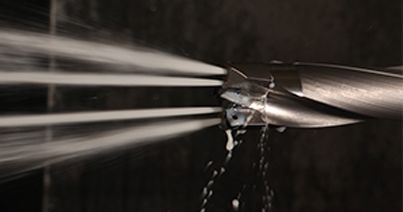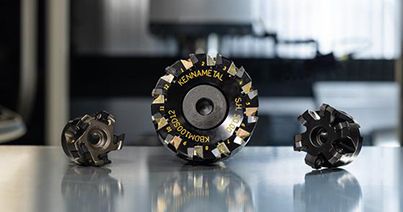Turning is a fundamental operation in metal cutting that often faces challenges, which can compromise both quality and efficiency if not constantly monitored – increasing downtime and costs. To overcome these challenges effectively, it's essential to analyze potential mechanism failure and implement the appropriate corrective actions. This guide provides expert advice on identifying and resolving common problems in turning operations to enhance performance and tool longevity.
Edge Wear
Problem: Gradual erosion of the cutting edge due to friction and heat during the cutting process.
Solution:
- Increase feed rate which enhances the material removal rate, reducing the time the tool has in contact with the workpiece.
- Reduce the cutting speed which decreases the heat generated and minimizes wear.
- Utilize a more wear-resistant grade on the workpiece material or apply a grade with a coating which would provide additional protection against wear and will reduce friction and heat.

Edge Wear
Chipping
Problem: Small fragments breaking away from the cutting edge which are often due to excessive force or vibrations.
Solution:
- Utilize a more impact-resistant grade which can withstand higher forces without chipping.
- Consider proper edge preparation, such as using a larger hone or T-land which can enhance tool life.
- Ensure that the machine setup is rigid enough to prevent vibrations which can result in chipping.
- Increase the lead angle to distribute cutting forces more evenly.

Chipping
Thermal (Heat) Deformation
Problem: The distortion of the cutting edge due to excess heat and pressure which causes the tool to lose its shape during the cutting process.
Solution:
- Reduce the speed to help manage heat generation.
- Decrease the feed rate to reduce the amount of heat generated.
- Reduce the Depth-of-Cut (DOC) to minimize heat buildup.
- Select a grade that maintains its hardness at high temperatures.

Thermal (Heat) Deformation
Depth-of-Cut Notching
Problem: Formation of a notch at the depth of cut, often due to repeated stress at this specific point.
Solution:
- Increase the lead angle to distribute cutting forces more evenly.
- Consider proper edge preparation, such as using a larger hone or T-land which can enhance tool life.
- Decrease the speed and the feed rate to compensate for surface irregularities.

Depth-of-Cut Notching
Thermal Cracking
Problem: Cracks develop in the tool due to rapid temperature changes during the cutting process.
Solution:
- Ensure adequate coolant supply to manage temperature fluctuations or remove coolant completely
- Reduce the speed to help manage temperature fluctuations
- Decrease the feed rate to help manage temperature changes
- Apply a coated grade to help manage rapid temperature changes

Thermal Cracking
Built-Up Edge
Problem: Accumulation of workpiece material on the cutting edge, affecting cutting performance and surface finish.
Solution:
- Increase the cutting speed to achieve higher cutting temperatures to reduce the formation of built-up edge.
- Increase the feed rate to help clear material from the cutting edge
- Apply coated carbide grades or cermet inserts to reduce built-up edge formation
- Utilize adequate coolant pressure to minimize heat and reduce buildup
- A smaller hone on the cutting edge can reduce the tendency for material to stick to the cutting edge

Built-Up Edge
Crater Wear
Problem: Formation of a crater-like depression on the tool face, usually due to high temperatures and chemical reactions.
Solution:
- Decrease the feed rate to reduce crater formation
- Decrease the cutting speed to achieve lower cutting temperatures and reduce crater formation
- Apply coated carbide grades or cermet inserts to reduce crater formation
- Utilize adequate coolant pressure to minimize heat and reduce crater-like depressions

Crater Wear
Catastrophic Breakage
Problem: Sudden and complete failure of the cutting edge, often due to excessive force or improper setup. Breakage is a secondary failure mode resulting from other types of tool failure.
Solution:
- Utilize a more impact-resistant grade which can withstand higher forces without chipping.
- Decrease the feed rate to prevent excessive force on the cutting edge
- Reduce Depth-of-Cut (DOC) to minimize the risk of breakage
- Ensure the machine setup is rigid to prevent vibrations that can lead to breakage
- Ensure that the machine setup is rigid enough to prevent vibrations which can result in breakage

Catastrophic Breakage
Conclusion
By implementing the necessary corrective actions to address these common issues, substantial enhancements in the quality and efficiency of turning operations can be realized. Furthermore, regular machine maintenance and precise adjustments can enhance performance and extend tool life, ensuring successful project outcomes.
Related Articles
- Machining Guide: Cutting Fluid Tips for Holemaking OperationsHolemaking is challenging work. This article provides some CNC coolant application tips for making drilling operations easy and productive. Read more.Holemaking is challenging work. This article provides some CNC coolant application tips for making drilling operations easy and productive. Read more.
- Webinar: Unlock Efficiency with Autodesk Fusion and Kennametal Tooling SolutionsDiscover how to import Kennametal tooling data into Autodesk Fusion and optimize your manufacturing processes with our in-depth webinar.Discover how to import Kennametal tooling data into Autodesk Fusion and optimize your manufacturing processes with our in-depth webinar.
- Essential Tips for Troubleshooting Indexable MillingEffective troubleshooting in indexable milling requires a systematic approach to identify and resolve issues. Here’s some advice on common problems.Effective troubleshooting in indexable milling requires a systematic approach to identify and resolve issues. Here’s some advice on common problems.



